Intel Haswell Low Power CPU Review: Core i3-4130T, i5-4570S and i7-4790S Tested
by Ian Cutress on December 11, 2014 10:00 AM ESTProfessional Performance: Windows
Agisoft Photoscan – 2D to 3D Image Manipulation: link
Agisoft Photoscan creates 3D models from 2D images, a process which is very computationally expensive. The algorithm is split into four distinct phases, and different phases of the model reconstruction require either fast memory, fast IPC, more cores, or even OpenCL compute devices to hand. Agisoft supplied us with a special version of the software to script the process, where we take 50 images of a stately home and convert it into a medium quality model. This benchmark typically takes around 15-20 minutes on a high end PC on the CPU alone, with GPUs reducing the time.
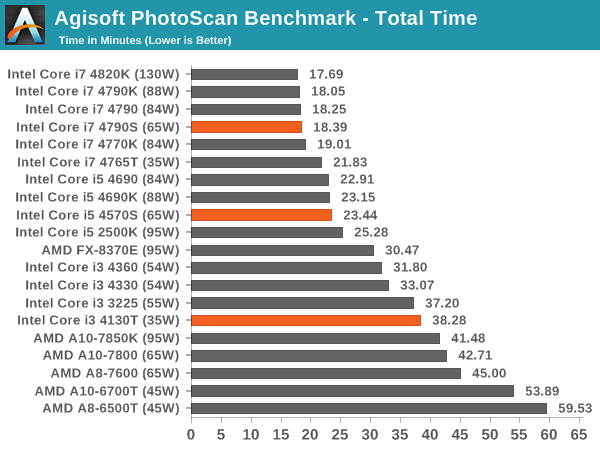
Cinebench R15

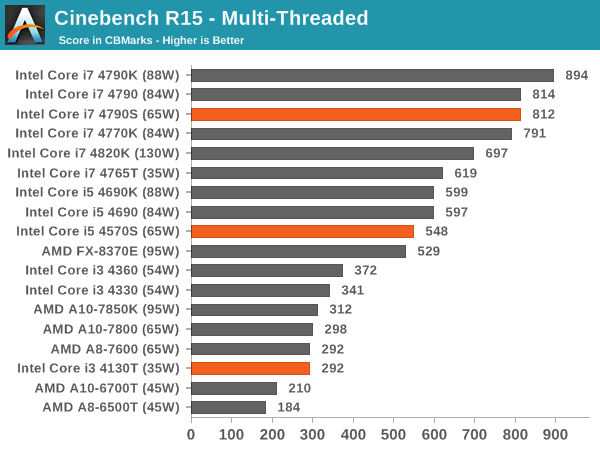
Professional Performance: Linux
Built around several freely available benchmarks for Linux, Linux-Bench is a project spearheaded by Patrick at ServeTheHome to streamline about a dozen of these tests in a single neat package run via a set of three commands using an Ubuntu 14.04 LiveCD. These tests include fluid dynamics used by NASA, ray-tracing, molecular modeling, and a scalable data structure server for web deployments. We run Linux-Bench and have chosen to report a select few of the tests that rely on CPU and DRAM speed.
C-Ray: link
C-Ray is a simple ray-tracing program that focuses almost exclusively on processor performance rather than DRAM access. The test in Linux-Bench renders a heavy complex scene offering a large scalable scenario.
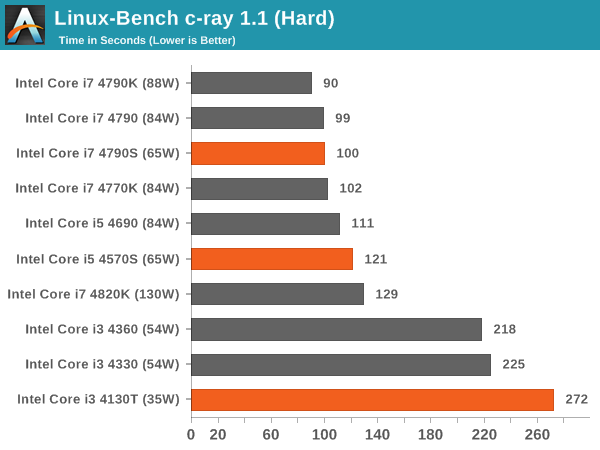
NAMD, Scalable Molecular Dynamics: link
Developed by the Theoretical and Computational Biophysics Group at the University of Illinois at Urbana-Champaign, NAMD is a set of parallel molecular dynamics codes for extreme parallelization up to and beyond 200,000 cores. The reference paper detailing NAMD has over 4000 citations, and our testing runs a small simulation where the calculation steps per unit time is the output vector.
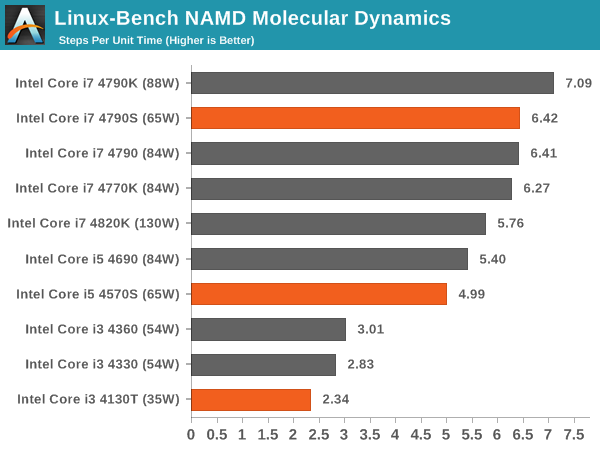
NPB, Fluid Dynamics: link
Aside from LINPACK, there are many other ways to benchmark supercomputers in terms of how effective they are for various types of mathematical processes. The NAS Parallel Benchmarks (NPB) are a set of small programs originally designed for NASA to test their supercomputers in terms of fluid dynamics simulations, useful for airflow reactions and design.
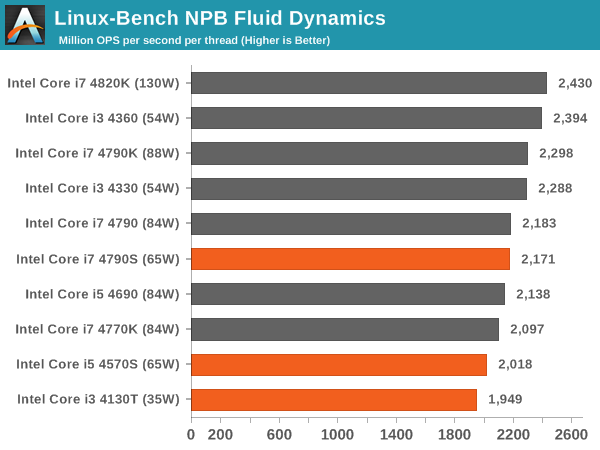
Redis: link
Many of the online applications rely on key-value caches and data structure servers to operate. Redis is an open-source, scalable web technology with a b developer base, but also relies heavily on memory bandwidth as well as CPU performance.
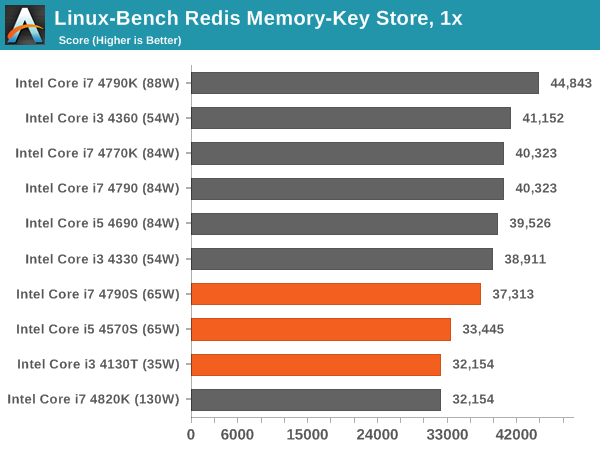
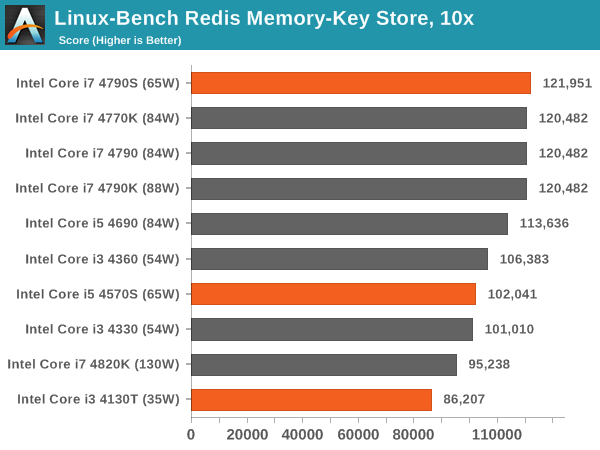











76 Comments
View All Comments
azazel1024 - Thursday, December 11, 2014 - link
Can we also move away from having a GPU in the system for tested idle and load power consumption? It is one more source of bluring on what is actually using the power. Everything on the chart has an iGPU and in most cases businesses or low power users are going to be leaning on the iGPU, not a dGPU. So seeing what system power consumption is without a dGPU is important, even if all systems have the same contribution from an identical dGPU (it means a lot more if the dGPU is contributing 10w at idle...so suddenly you have a 3w difference between processor models...but the idle is 10w for one and 13w for another, instead of 20w and 23w).barleyguy - Thursday, December 11, 2014 - link
Delta charts are more accurate, and easier to generate, than absolute numbers. An absolute number will either be "total system power" or "total system power minus an estimate of non-processor power". The first is useless as information about the processor, because it isn't comparable across platforms, and the second is only an estimate unless hardware mods are done for power taps. For a chart that has such a large number of processors on it, the estimation errors for calculating discrete draw would likely put the chips in the wrong order.rootheday3 - Thursday, December 11, 2014 - link
For people who are using the onboard graphics, a 1250 power supply, even one that is Gold rated, is going to be pretty inefficient at low power.I know it is nice/convenient to have a single common setup for testing both with and without graphics and it makes things "apples-to-apples" but it doesn't match how I would build a system. If I really only intend to use the onboard graphics, I would try to pick a power supply that was sized appropriately.
For users trying to understand the platform/cpu idle and load power, it seems like it would be beneficial to have both idle and load power reported AND appropriately sized power supply for the test conditions.
Daniel Egger - Thursday, December 11, 2014 - link
> If I really only intend to use the onboard graphics, I would try to pick a power supply that was sized appropriately.Good luck with that. There're almost no appropriately sized PSUs for such systems available on the market; seems like they're all exclusively designed for and sold to big OEMs.
azazel1024 - Thursday, December 11, 2014 - link
Not really. The idle power of the CPU very well might be different between the different CPUs combined (which can be sussed out if they all use the same hardware configuration excepting the CPU). Idle to load might only be a 10w difference for one CPU...but it might idle using 20w for the CPU. Another CPU might be a 15w difference from idle to load, but it might idle at 5w...making it a much more power efficient CPU overall.rootheday3 - Thursday, December 11, 2014 - link
At idle, CPUs enter pkg c states and burn less than 1w regardless of sku/stepping/binningpiasabird - Thursday, December 11, 2014 - link
http://download.intel.com/support/processors/corei...It must be because intel is not selling the CPU's in boxed retail set. 4360T, 4350T, 4330T, 4160T, 4150T, 3250T are not available boxed, but are valid parts. My guess is you have to order them as tray and are only available to OEM's. However, they may be available through a small OEM custom computer builder shop.
sweetie peach - Thursday, December 11, 2014 - link
I have been using the i7-4790S for the past 4 months and there is something very strange about the results. The cinebench multithreaded bench is way too high. This cpu turbos to 3.6GHz with 4 cores so it can not possibly have the same score as a non-S that turbos to 3.8 GHz with 4 cores. Also my own average results are 160 for single and 740 for multi (HT enabled of course). Maybe there is something wrong with my setup but it doesn't feel slow in any way. It was very difficult to get hold of but it made sense because i want a very quiet computer even at load.otherwise - Thursday, December 11, 2014 - link
Do any of these support ECC? Or do you still need a sandy-bridge era i3 to get that feature?Cerb - Sunday, December 14, 2014 - link
Most, if not all, the Haswell Core i3 CPUs support ECC, as do all of the Xeon E3 V3 series.